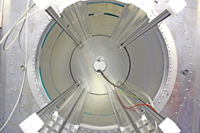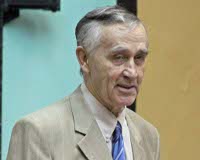From interactions: DESY and TRIUMF take home top prizes from the first Global Particle Physics Photowalk

This image of the 8Pi nuclear-physics experiment won first place in the global jury competition, and third place in TRIUMF's local competition. The muted black and white image of the 8Pi experiment's inner detectors captures the beauty and symmetry of physics. Photographer: Mikey Enriquez, laboratory: TRIUMF |
14 October 2010 – A sunburst image of a particle detector at Germany's DESY laboratory and a black-and-white photograph of a nuclear-physics experiment at TRIUMF in Canada have won the top prizes in the first-ever Global Particle Physics Photowalk.
More than 100 of the top photographs from the photowalk, including the six winners of the jury and "people's choice" competitions, are now viewable online.
Read more...
|
 |
|
|
 |
| Upcoming meetings, conferences, workshops
 International Workshop on Linear Colliders 2010 (IWLC2010)
ECFA-CLIC-ILC joint meeting International Workshop on Linear Colliders 2010 (IWLC2010)
ECFA-CLIC-ILC joint meeting
CERN and CIGC, Switzerland
18-22 October 2010
2010 IEEE Nuclear Science Symposium and Medical Imaging Conference
Knoxville, Tennessee, USA
30 October - 6 November 2010
SiD Workshop
University of Oregon, Eugene, Oregon, USA
15-17 November 2010
X-Band Structures, Beam Dynamics and Sources Workshop (XB-10)
Cockcroft Institute, Daresbury, UK
30 November - 3 December 2010
Upcoming schools
Fifth International Accelerator School for Linear Colliders
Villars-sur-Ollon, Switzerland
25 October - 5 November 2010
US Particle Accelerator School (USPAS)
Old Dominion University, Hampton, Virginia, USA
17-28 January 2011
|
|
|
GDE Meetings calendar
View complete ILC calendar
|
|
|
 |
 |
|
|
 |
Final curtain for EUDET
EU project comes to a close and leaves the stage for AIDA

The inside of the superconducting 'PCMAG' magnet – making it available for detector prototypes is one of the achievements of the EUDET programme. Image: DESY / Jessica Klein. |
After four plus one years of running time, a total budget of 21.5 million Euros, participating institutes from Helsinki to Valencia and from Novosibirsk to Glasgow and many research infrastructures successfully in place, the EU-funded infrastructure programme for ILC detector R&D EUDET comes to a close at the end of the year. Participants met for the very last EUDET meeting at DESY last week. But instead of self-congratulatory speeches and boasting summaries, most of the talks listed future plans and outlined future milestones beyond the scope of EUDET – particle physicists will be particle physicists. Many of them are already working on the next project for detector development and infrastructures, AIDA, in many ways a follow-up to EUDET.
Read more...
-- Barbara Warmbein |
 |
|
|
 |
From Science Daily
12 October 2010
Large Hadron Collider Used to Recreate Miniature Version of Beginning of Universe
The research published this week falls into the latter category and is about determining the mass of a theoretical particle known as an "excited quark."
Read more... |
|
From NewScientist
11 October 2010
Giant Antarctic balloon sees surprise cosmic rays
A neutrino telescope that makes use of thick Antarctic ice and a giant balloon is unexpectedly detecting mysterious, ultra-high-energy cosmic rays.
Read more... |
|
From Ria Novosti
7 October 2010
Россия может рассчитывать на получение коллайдера ILC, считают физики
Россия имеет неплохие шансы получить право на постройку Международного линейного коллайдера - такое мнение высказали ученые в рамках научного кафе, прошедшего в четверг в посольстве Великобритании.
Read more... (in Russian) |
|
|
 |
Novosibirsk revisited: integrating former weapons scientists

Alexander Skrinsky, Director of the Budker Institute and host of the meeting, greeting the ISTC seminar |
Last week I wrote about the Budker Institute for Nuclear Physics in Novosibirsk, Russia, the venue for the 13th CERN-ISTC Scientific Advisory Committee Seminar entitled "New Perspectives of High Energy Physics," where I was an invited speaker on the International Linear Collider. The acronym ISTC stands for International Science and Technology Center, created in 1992 as an intergovernmental organisation for approving, financing and monitoring projects that could help stem the proliferation of weapons of mass destruction. This year's ISTC-sponsored seminar on high-energy physics was very well attended and included participation of many prominent lecturers and young scientists.
Read more...
-- Barry Barish
Director's Corner Archive |
 |
|
|
 |
CALICE, camels, Casablanca

The CALICE collaboration is beyond the beginnings of wonderful friendships — at their recent meeting in Casabanca, Morocco, they didn't only reelect their spokesman, compiled an extensive test beam programme for the next year and reported on the the successful mass production of 10 000 ASIC chips but also had some time for camel trekking. Pictured: Kiyotomo Kawagoe, Jae Yu, Tohru Takeshita and Felix Sefkow. Read more in future issues of ILC NewsLine.
|
arXiv preprints
1010.1931
Probing Anomalous Top-Gluon Couplings at Colliders
1010.1337
Summary of the Linear Collider Testbeam Workshop 2009 – LCTW09
|
|

